Kleine Brogel Nukes: Not There, Over Here!
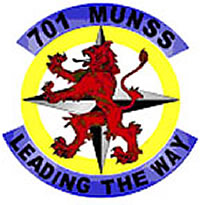 |
| The U.S. Air Force’s 701 Munitions Support Squadron at Kleine Brogel Air Base must protect and handle the nuclear weapons at the base. |
An astounding statement by a Belgian defense official has pointed an unexpected light on the apparent location of nuclear weapons at the Kleine Brogel Air Base in Belgium.
After a group of peace activists climbed the base fence and made their way deep into an area assumed to store nuclear weapons, Ingrid Baeck, a chief spokesperson for the Belgian Ministry of Defense, bluntly told Stars and Stripes: “I can assure you these people never, ever got anywhere near a sensitive area. They are talking nonsense….It was an empty bunker, a shelter,” she said and added: “When you get close to sensitive areas, then it’s another cup of tea.”
Baeck did not go so far as to explicitly confirm or deny if there were nuclear weapons on the base, but the Belgium Ministry of Defense’s mission statement for the 10th Tactical Wing clearly shows that it has a nuclear mission (see Figure 1).
| Figure 1: Belgian 10th Tactical Wing Mission |
 |
| The Belgian Ministry of Defense’s mission statement for the 10th Tactical Wing (10 W Tac) at Kleine Brogel clearly lists a nuclear mission. Emphasis added. |
.
Shelter Searching
It is unclear whether Baeck as a spokesperson actually knows where the weapons are stored or if “sensitive area” only refers to the particular shelter the activists reached. But her statement that the activists “ever got anywhere near a sensitive area” inadvertently redirects the attention to the western area of the base.
Kleine Brogel has 26 Protective Aircraft Shelters (PAS) located in three clusters: Area 1 at the western part of the base with 11 shelters; Area 2 at the center of the base also with 11 shelters; and Area 3 at the eastern end of the base with four shelters (see Figure 2).
| Figure 2: Nuclear Weapons Storage Areas |
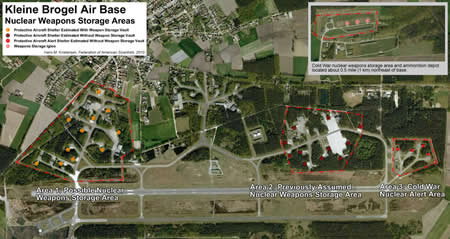 |
| Estimated locations for nuclear weapons at Kleine Brogel Air Base have changed over the years. Click image for large version. |
.
During the Cold War, nuclear weapons were stored in the Weapons Storage Area northeast of the base, while aircraft loaded with nuclear weapons stood alert in the shelters in Area 3.
Area 2 has long been the suspected nuclear weapons storage area, given its 11 shelters, pronounced fencing, and separation from the outer base perimeter. This is the area the activists managed to penetrate on January 31st.
Baeck’s statement appears to draw the attention to Area 1 at the western end of the base where 11 shelters are clustered. It also has an additional fence perimeter that appears to have been improved since 2006, but the gates were open on a satellite image dated April 8, 2007. Moreover, the area is close to the outer base fence, with the busy N748 highway only 225 feet (68 meters) from one shelter and another shelter only 134 feet (40 meters) from a residential neighborhood. Jeffrey L also has an interesting photo interpretation.
Whether the nuclear shelters necessarily have to be in one cluster inside the same perimeter is unknown, although safety and management issues seem to suggest so.
The Weapons Security and Storage System (WS3)
Only 11 of the 26 Protective Aircraft Shelters at Kleine Brogel are equipped with the Weapons Storage Security System (WS3), a nuclear weapons storage system unique to Europe. The system at Kleine Brogel was completed in 1992.
The mechanical part of the WS3 includes a Weapons Storage Vault (WSV), a reinforced concrete foundation and a steel structure recessed into the floor of the shelter. The vault platform can be elevated out of the concrete foundation by means of an elevator drive system to provide access to the weapons in two stages or levels, or can be lowered into the floor to provide protection and security for the weapons. The floor slab is approximately 16 inches (40 cm) thick. Sensors to detect intrusion attempts are embedded in the concrete vault body.
Each of the 11 vaults can store up to four B61 bombs, but normally contains only one or two for a total of 10-20 bombs currently at Kleine Brogel.
Location of the vault inside the shelter depends on the size of the shelter and the proximity of conventional weapons storage racks. Two layouts are in use (see Figure 3), and the vaults at Kleine Brogel are the smaller located at the front-left end of the shelter.
| Figure 3: Weapons Storage Vaul Locations |
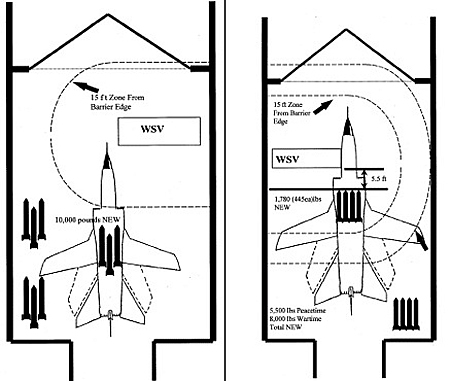 |
| The location of the underground Weapons Storage Vault depends on the size of the aircraft shelter. Kleine Brogel shelters use the right-hand layout. |
.
The vaults are rarely visible on photos from outside the shelters, but in this unique photo (see Figure 4) taken at nearby Volkel Air Base in the Netherlands in 2009 the outline of the vault can be seen in the front-left corner (right in the picture) of the shelter.
| Figure 4: External View of Munitions Storage Vault |
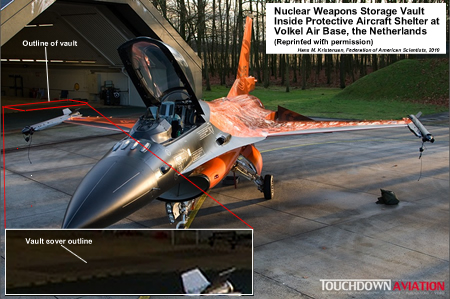 |
| A vault cover is visible inside this shelter at Volkel Air Base in the Netherlands. The picture of the specially painted F-16 (no. J-015) was taken during a pilot ceremony in 2009. Reprinted with permission. Original photo at Touchdown Aviation. |
.
The vault can be elevated in two stages, halfway to provide access to the top rack, or fully to provide access to the lower rack as well. An example of halfway elevation is the photo below showing the command of U.S. Air Forces in Europe, General Roger Brady, receiving a briefing next to a vault at Volkel Air Base in June 2008 (see Figure 5) (he also visited Kleine Brogel). The visits happened shortly after the Blue Ribbon Review report concluded that “most sites” storing nuclear weapons in Europe did not meet DOD security standards.
| Figure 5: Halfway Elevation of Weapons Storage Vault |
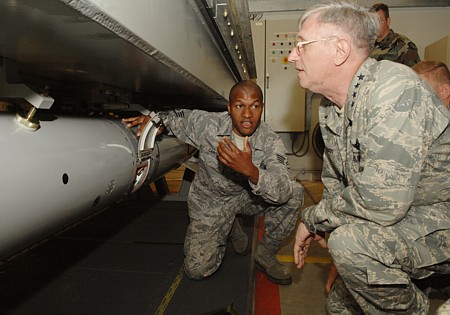 |
| This picture, taken inside a shelter at Volkel Air Base, shows Gen. Grady receiving a briefing from a member of the 703rd MUNSS. The vault is halfway raised showing one B61 bomb, with the lower bomb rack hidden below the floor level. |
.
If fully elevated the vault appears as on the image below (see Figure 6). The base name is unknown, but given the location of the vault it appears to be inside a large shelter at a U.S. base, possibly Aviano Air Base in Italy or Ramstein Air Base in Germany (all B61s were removed from Ramstein in 2005).
| Figure 6: Full Elevation of Weapons Storage Vault |
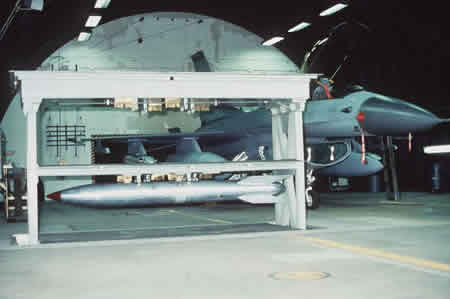 |
| Full elevation of the Weapons Storage Vault inside what appears to be an aircraft shelter at Aviano Air Base or Ramstein Air Base. |
.
What is Security?
Kleine Brogel base commander Col. Fred Vansina insisted that the penetration of the base by the activists did not constitute a security incident: “Our installations are very well secured, in different ways,” there was “no single security incident, whatever the activists claim.”
A nuclear base is a sensitive area and unauthorized personnel meandering around deep inside its inner perimeters is a security incident, but Vansina’s definition appears to require an unauthorized and dangerous approach of a nuclear facility. Both he and Baeck have great confidence in the WS3 and the security forces’ ability to protect the weapons under all circumstances.
I agree that it would be very difficult for anyone to steal or destroy the weapons under normal circumstances when they’re stored underground. But it is the abnormal circumstances that concern me; weapons are occasionally brought up from the vault, serviced, and moved (see Figure 7). Overconfidence is dangerous because incidents and accidents have a nasty habit of happening in ways that were not anticipated. And that requires us to weigh the risks against the necessity of the deployment, a necessity I have an increasingly hard time to see.
| Figure 7: Halfway Elevation of Weapons Storage Vault |
 |
| The safety of the underground Weapons Storage Vault no longer applies when nuclear bombs in Europe are brought up for maintenance or transport. A 1997 Air Force study even found a risk of lightning causing a nuclear detonation. |
.
Status of Nuclear Weapons in Europe
The 10-20 weapons at Kleine Brogel are part of a stockpile of an estimated 150-200 U.S. nuclear bombs scattered in 87 vaults at six bases in five countries, a reduction from approximately 480 bombs in 2001. My current estimate looks like this (see Figure 8):
| Figure 8: |
 |
| Click image to download larger pdf-version. |
This publication was made possible by a grant from Carnegie Corporation of New York and Ploughshares Fund. The statements made and views expressed are solely the responsibility of the author.
The grant comes from the Carnegie Corporation of New York (CCNY) to investigate, alongside The British American Security Information Council (BASIC), the associated impact on nuclear stability.
Satellite imagery of RAF Lakenheath reveals new construction of a security perimeter around ten protective aircraft shelters in the designated nuclear area, the latest measure in a series of upgrades as the base prepares for the ability to store U.S. nuclear weapons.
It will take consistent leadership and action to navigate the complex dangers in the region and to avoid what many analysts considered to be an increasingly possible outcome, a nuclear conflict in East Asia.
How the United States responds to China’s nuclear buildup will shape the global nuclear balance for the rest of the century.